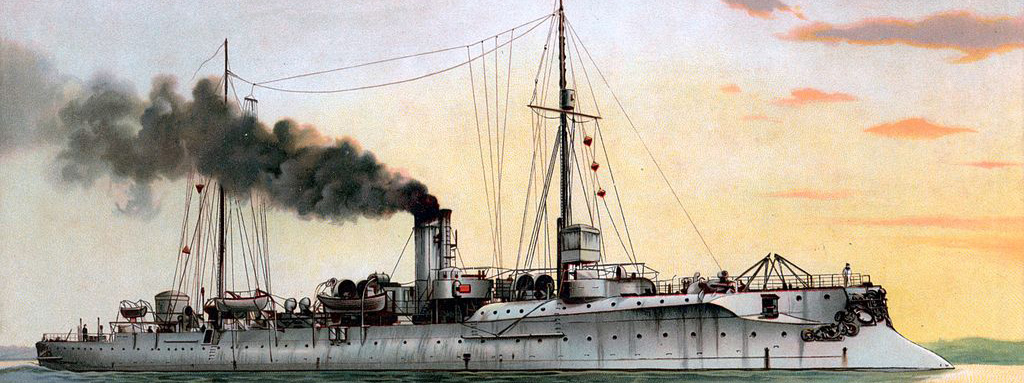
 Germany, Aviso-Cruiser, 1895-1914
Germany, Aviso-Cruiser, 1895-1914WW1 German Cruisers
Irene class | SMS Gefion | SMS Hela | SMS Kaiserin Augusta | Victoria Louise class | Prinz Adalbert class | SMS Prinz Heinrich | SMS Fürst Bismarck | Roon class | Scharnhorst class | SMS BlücherBussard class | Gazelle class | Bremen class | Kolberg class | Königsberg class | Nautilus class | Magdeburg class | Dresden class | Graudenz class | Karlsruhe class | Pillau class | Wiesbaden class | Karlsruhe class | Brummer class | Königsberg ii class | Cöln class
SMS Hela was a cruiser of the Imperial German Navy, initially classed as an “aviso” (despatch vessel). She was commissioned by the Weser Shipyards in Bremen (AG Weser) and launched in Kiel on March 28, 1895. She was named after the Hel Peninsula near Danzig and commissioned on May 3, 1896. As an aviso from 1898, First Division, First Squadron. she escorted the Imperial Yacht SMY Hohenzollern in Scandinavia and later to Palestine. She was in the Atlantic squadron, visited Diver and the Netherlands as well as Sweden and was later converted into a lightly armed light cruiser, with eight 8.8 cm guns. She took part in the Boxer war, and was still in service at the start of the First World War. She was sunk by a British submarine on September 13, 1914.
The Kaiserliche Marine’s last “Aviso”
Development
SMS Hela was surely the oldest active German cruiser in service when the war broke out in August 1914. She was originally classified as “aviso”. In reality, by her tonnage and speed, she was comparable to a light cruiser and was named as such afterwards. She represented significant improvements over the Wacht and Meteor classes, a disappointment in service. She needed to act as fleet scout and flotilla leader for torpedo boats. She marked a step toward the development of the light cruiser when armed with a battery of four 8.8 cm (3.5 in) guns and three 45 cm (17.7 in) torpedo tubes, meaning she was only good for screening duties but absolutely not for front-line combat.
Started in Weser (Bremen) in 1893 on the basis of the enlarged Jagd class (1887), she was also more powerful and fast, armored (25 mm deck) but lightly armed, retaining, however, their general appearance.
When ordered, she retook the name of the 1852 schooner Hela and was the culmination in development of the “aviso” type developed from earlier torpedo boats, intended for home waters as flotilla leaders for torpedo boats and scouts for the capital ships. SMS Zieten was the first of these, purchased from a British shipbuilder in 1875 and in Germany, seven more were built in the the early 1890s. The last four included the Wacht and Meteor classes. They proved bad steamers, unseaworthy, and completely unfit for their mission in service. In 1893, the naval construction staff prepared a new design provisionally designated “H”. It was tackling all the issues spotted on the previous designs, addressing them one by one. A large part of the solution was just an increase in size.
This, thus helped making the transition to aviso, to the proper light cruiser in the German Navy. They would be referred to as “leichte kreuzer” and German designers incorporated the best aspects of the vessels which worked for them, notably a high top speed and, an armor deck, and they were compared favourably even to the master unprotected cruisers of the Bussard class, albeit the latter had an heavier armament and long cruising radius (thanks to the masts). By combining the best features of the Bussard class and of Hela, was created the Gazelle-class cruisers, first true light cruisers of the Kaiserliches Marine.
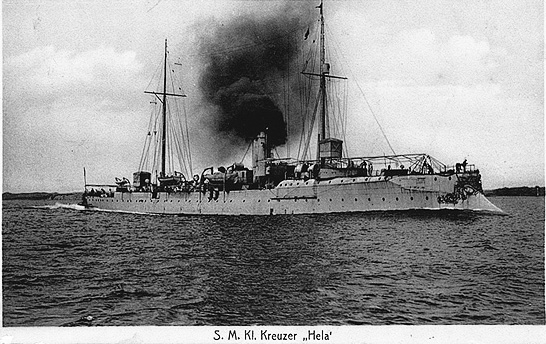
Design
The H project was developed from armored avisos of the “Jagd” type. Foreign analogues of German “Avisos” were minelayer cruisers or scouts. These ships were intended for reconnaissance and messenger service for squadrons. “Hela” stood out among the German cruisers of that time with a ram of considerable size, which was not typical for German shipbuilding. Despite her modest displacement, the cruiser’s seaworthiness was considered very good, one key aspects redressed from previous designs.
Hull design and general Layout
Hela measured 104.6 meters (343 ft 2 in) long at the waterline, 105 m (344 ft 6 in) overall. Her beam was 11 m (36 ft 1 in) and she had a draft of 4.46 m (14 ft 8 in) forward, 4.64 m (15 ft 3 in) aft. Her planned displacement as calculated was 2,027 t (1,995 long tons), and at full load, this displacement rose to 2,082 t (2,049 long tons). Her hull used transverse and longitudinal steel frames creating an internal compartmentation with 22 watertight cells, above the armored deck, ten below. Underneath was a double bottom over 35% of the total length. The raised forecastle for ended in a pronounced ram bow. Like all previous avisos, Hela had a minimalstic superstructure, and small conning tower. The raised forecastle deck extended from the stem to the funnel and the poop was in the clipper style. She also had fitted two light pole masts fitted with spotting tops fore and aft, straight and not raked as usually seen.
Hela had a crew composed of 7 officers and 171 ratings, as completed. Later it was increased to 8 officers and 187 ratings. She carried a fleet of small boats comprising a single coal barge, one yawl, three dinghies. Later the barge was landed and a picket boat installed.
Powerplant
Hela was outfitted with two, 3-cylinder, triple expansion steam engines, powered by the steam coming from six locomotive-type boilers. Each VTE engine drove a shaft wiyh a screw propeller, three bladed and 3.25 m (10 ft 8 in) in diameter. Each engine had its own separate engine room for extra safety if flooded. The six locomotive boilers were split into two separated boiler rooms, also for safety, and they however ducted and truncated into a single funnel amidships. The power rating 6,000 metric horsepower (5,900 ihp) and top speed was 20 knots (37 km/h; 23 mph). On trials she achieved a half knot better than her constracted speed. Coal storage amounted to 340 long tons (350 t). Range figures when completed are unknown. Hela also had three electrical generators in order to produce 36 kilowatts at 67 volts, powering some essentialsystem when the machinery was cold.
During modernization, these old school boilers were replaced by eight of a proper marine type, brand new. The appearance of the ships somewhat changed with it. Top speed in sea trials after this refit were impressive 20.5 knots (for 1896) and final cruising range was established to 3,000 miles at 12 knots, with coal reserves increased from 370 to 412 tons.
SMS Hela was very seaworthy but rolled badly, with a measured metacentric height of 0.775 m (2 ft 6.5 in). She tended take a lot of seawater and plough in a head sea as being slightly bow-heavy, which the prounonced ram bow did not improved. Like torpedo boats she alsh had an upper hull (above the waterline) that was rounded. Steering called for a single rudder and she only had average maneuverability, bleeding a lot of speed in hard turns.
However, during her career, she had recurring boilers issues. Between 1903 and 1906 she was overhauled and modernized. In 1910, she sported new boilers and two funnels, new superstructures, and two less 88 mm guns. She suffered a collision with torpedo boat S121, and in 1914 was assigned to the IV group of scouts. She was torpedoed in by HMS E9 en route between Wilhelmshaven and Helgoland on 13 September 1914 and sank slowly (25 minutes) allowing all her crew to orderly evacuate.
Protection
The cruiser’s armor turned out to be very weak, as it was not the main requirement:
The armor deck was 20 mm (0.79) thick for its flat part, thickened at the bevels to 25 mm or 1 inch.
The conning tower had light walls made of 30 mm or 1.2 inches.
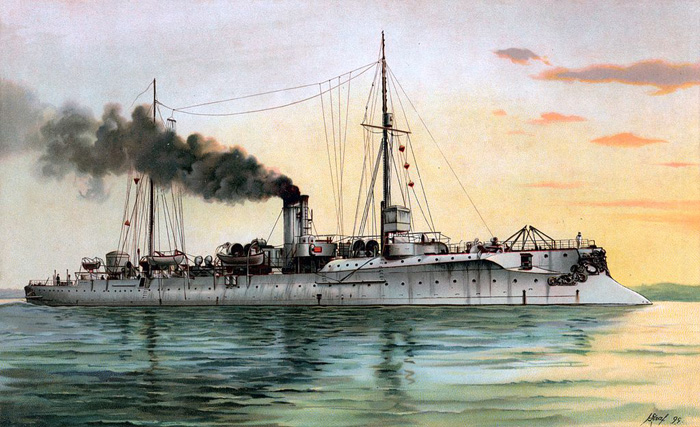
Armament
88-mm SK L/30 guns
The main caliber was limited to two 88-mm SK L/30 guns for and aft of the forecastle and poop.
They fired 7 kg (15 lb) HE shells up to 6900 m, with an initial velocity of 590 m/s (1,900 ft/s).
Storage was 800 rounds total, 200 per gun. Elevation was 10-20° on their MPL C/89 mounts.
The rate of fire, in favorable conditions, was up to 15 rounds per minute.
50-mm SK L/40 guns
The auxiliary caliber consisted of six 50 mm SK L/40 guns on the broadside.
They were fitted on in individual Torpedobootslafette (Torpedo Boat Mount) C/92 elevating to 20 degrees.
Muzzle velocity was 2,152 ft/s (656 m/s).
They fired 1.7 kg (3.8 lb) shells at a range of up to 6,200 m (6,760 yd).
The ship carried a total of 1,500 rounds, or 300 per gun.
Rate of fire was 10 rounds per minute, they were even slower than the main guns.
Torpedo Tubes
She also had three fixed torpedo tubes, 450 mm (18 in), 87.5 kg (193 lb) warhead: One forward, two on the broadside. They fired the standard Schwartzkopf torpedoes at the time capable of 32 knots and 500 m (1600 ft) or on the 26 knots (48 kph) setting to 800m (2600 ft).
Illustration of the Hela in 1914
⚙ Hela specs 1914 |
|
| Displacement | 2,027 t standard, 2,082 t FL. |
| Dimensions | 105 x 11 x 4.64m (344 ft 6 in x 36 ft 1 in x 15 ft 3 in) |
| Propulsion | 2 shafts, 2x 2-cyl. TE steam engines, 6× loco boilers: 6,000 PS (5,900 ihp) |
| Speed | 20 knots (37 km/h; 23 mph) |
| Range | 3,000 nmi (5,600 km; 3,500 mi) at 12 knots (22 km/h; 14 mph) |
| Armament | 4× 8.8 cm SK L/30, 6× 5 cm SK L/40, 3× 45 cm TTs |
| Protection | Deck 20-25 mm (0.79 to 0.98 in), CT 30 mm (1.2 in) |
| Crew | 7 officers+ 171 enlisted men |
Main Modernization
Career of SMS Hela
SMS Hela was laid down in December 1893 at AG Weser shipyard, Bremen under the provisional name “H”. She was launched on 28 March 1895. The ceremony was attended by Vizeadmiral Victor Valois, chief of the Marinestation der Nordsee. He also christened the ship. She was completed later at Kaiserliche Werft in Wilhelmshaven, receiving her final fitting out by January 1896. She was commissioned for sea trials on 3 May under command of Korvettenkapitän Johannes Stein, later replaced by Kapitänleutnant Carl Schönfelder, in August. He trials were stopped when her engines were damaged in a high speed run, and this was severed enough she was decommissioned for repairs from 19 September for a months and a half.
Recommissioned on 10 March 1898 under command of KK Fritz Sommerwerck, she was assigned to I Squadron as its sole “aviso”. On 14 June, Hela escort Kaiser Wilhelm II’syacht Hohenzollern for a regatta in German waters, Norwegian waters that summer, and a stop at Hardangerfjord. On 31 July she was back to her squadron duties. She was detached for the same on 17 September after the annual fleet maneuvers. She escorted the Kaiser and his wife Augusta Victoria alongside the protected cruiser Hertha for a Mediterranean cruise and back on 8 December. KK Paul Rampold took command.
By early 1899, Hela and her Squadron cruised into the Atlantic. and while in the English Channel, they stopped in Dover to represent Germany at a celebration for Queen Victoria’s 80th birthday. This parade was on 1 May. In the summer, Hela escorted Hohenzollern for a cruise to Norway. During fleet maneuvers in August she operatied with a scouting unit. During exercises in the Baltic Sea (28 August) she struck the mole at Neufahrwassar, damaged her starboard propeller, later repaired to Kiel until 4 September, and back to complete the maneuvers. In mid-September, she escorted again SM Hohenzollern to Sweden, and escorted the recent battleship Kaiser Friedrich III to Britain with the Kaiser’s Yacht again from 17 to 30 November. She then made a training cruise with in the Skagerrak by December.
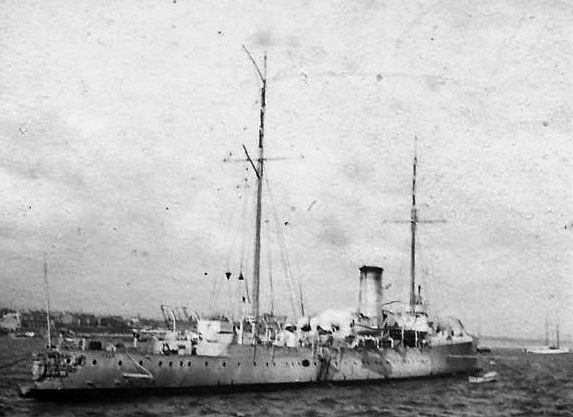
Hela in Kingstown, 1900
In early 1900 she multiplied training exercises with the fleet but her routine interrupted by what happened to westerners in China. On 20 June the Boxer Uprising saw the assassination of the German ambassador, Clemens von Ketteler by nationalists. This event trigerred a de factor alliance between Germany and seven other Great Powers concerned by the concession’s attacks. This was the start of the “Eight-Nation Alliance”. At the time to protect the concession there were only globally 400 officers and infantry. But Germany had there the East Asia Squadron: SMS Kaiserin Augusta, Hansa, Hertha, and Irene, Gefion, Jaguar and Iltis. There were 500 men in Taku fort as well. Other nations contributed 2,100 men. The were led by the dominant power in the region, British Admiral Edward Seymour. His expedition to Beijing was stopped at the Battle of Tientsin. Furious, the Kaiser wanted to create a massive international expeditionary force and Hela was assigned to the German own naval expedition on 4 July.
She sailed with four Brandenburg-class battleships, added to the existing German east asia squadron. They departed Kiel on 9 July, arrived off China by late August via Suez. Hela entered the Yangtze and patrolled the Yellow Sea until fall September. She had her landing party (4 officers, 74 men, marines and armed sailors) to participate in the assault on Chinese fortifications at the Shanhai Pass. In November she was in the Wusong roadstead until mid-December and back to the Yangtze. Next she was sent to Shanghai and back in the Yangtze in January 1901, via Zhenjiang, then Shanghai in February-March. KK Maximilian von Spee took command of Hela (yes, this one). She entered the recently developed German concession at Qingdao (Von Spee’s future Bastion in Asia) and back to Shanghai in May. She was recalled home, with KK Joachim von Bredow taking command and Von Spee remaining in Asia. On 1 June, thee expeditionary force also returned home, Wilhelmshaven on 11 August, mission accomplished.
Hela took part in the annual fleet maneuvers, notably with the I Scouting Group, from 26 August to 19 September and joined a cruise to Oslo by mid-December. Back in Wilhelmshaven she returned for manoeuvers in the main fleet in 1902, cruise in the Atlantic by May, detached to escort SMS Amazone, damaged off the Sevenstones Lightship for repairs. However at the time, the German high command was aware Hela was too weak even to act as fleet scout. She was sent to the Kaiserliche Werft, Kiel, on 16 October, to be modernized and rebuilt as training ship for light gunners of the Kaiserliches Marine. She was never to see the frontline again. KK Karl Zimmerman (future admiral) took command while she was in overhaul, completed by 21 December. She was recommissioned on 31 January 1903. However, an inspection revealed the poor condition of her boilers. They were overhauled at the Kaiserliche Werft, Danzig from 25 April. SMS Blitz replaced Hela as scout.

Hela post-reconstruction passing Grönningen, off Kristiansand. Despite some merits, Hela in operations showed the concept of aviso was less than ideal, even on her role. Underarmed, lightly protected, too slow, she was unable to conduct reconnaissance for the fleet or act as messenger (aviso). No other ship of that kind was ever built again.
Hela still for some took part in the I Scouting Group from June to September 1903 but this is contested by historians Hans Hildebrand, Albert Röhr, and Hans-Otto Steinmetz (no official records). No logbook exists in the archives so only due to location reports, the is no trace of her presence in Danzig, but whatever the case she was still there, inactive, until 1910, recommissioned on 1 October. She had sea trials on 14-18 October, acted as fleet tender and took part in maneuvers. On the night of 29–30 March 1911, S121 crossed her bow too closely and she pushed her, not with enough force to cause extensive damage. In April, KK Theodor Püllen took command. After summer drills, she was at the fleet review for the visit of the Austro-Hungarian Marinekommandant Admiral Rudolf Montecuccoli. She then carried Montecuccoli to visit Wilhelmshaven and Helgoland. Sge was sent to Kiel on 1 April 1912. In September, KK Carl-Wilhelm Weniger took command. By mid-1913, Italian Vice Admiral Prince Luigi Amedeo (Duke of the Abruzzi) visited Germany. On 31 May, she carried him to Helgoland, and see the fleet anchored there. In September, KK Paul Wolfram took command. She was her last.
As World War I broke out in late July 1914, Hela returned to active duty, assigned to the IV Scouting Group. She had to protect the German torpedo boats of the outer ring of coastal scouting patrols, in the German Bight. She was rearmed on 13-16 August, with a third 8.8 cm gun installed. She was stationed to the northeast of Helgoland with SMS Stettin.
On 28 August, British cruisers and destroyers (Harwich Force) rampaged the German patrol line, causing the Battle of Helgoland Bight. Hela turned east to engaged in the action until reveiving a contradictory report that the British were retreating. Fregattenkapitän Wolfram so reversed course, returned to this station, seeing no action. She joined the cruisers Kolberg and München to cover the remaining torpedo boats, reestablishing the Bight patrol line.
On 13 September, in the morning, Hela was attacked 6 nm (11 km; 6.9 mi) southwest of Helgoland by British sub. HMS E9 (Max Horton, future admiral). She was then in training and the area around Helgoland was “presumed safe” from submarines. E9 spotted her, re-submerged and fired two torpedoes, one struck her stern. After 15 minutes she rose to periscope depth and to their satisfaction, saw the old aviso sinking. In 15 minutes, she was gone. Her entire crew but two killed by the initial detonation, evacuated in good order and were rescued by nearny U-18 and a coastal patrol vessel. She was the first victim of British submarine. After this, training was banned from the area and moved to the Baltic. On of her 8.8 cm guns was later retrieved from her wreck and preserved at Fort Kugelbake, Cuxhaven.
Read More
Books
Conway’s All the World’s Fighting Ships, 1860—1905. — London: Conway Maritime Press, 1980.
Friedman N. Naval weapons of World War One. — Yorkshire: Seaforth Publishing, 2011. — 763 p.
Gröner, Erich. Die deutschen Kriegsschiffe 1815—1945. Kreuzer. Bernard & Graefe Verlag, 1982
Links
3D
https://free3d.com/3d-model/aviso-hela-imperial-german-navy-1567.html
Model Kits
None found. Got one to recommend ? Comment below !

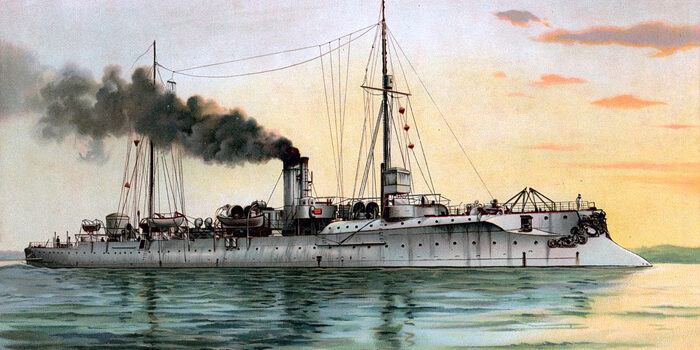
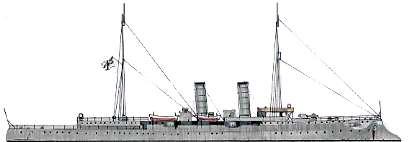
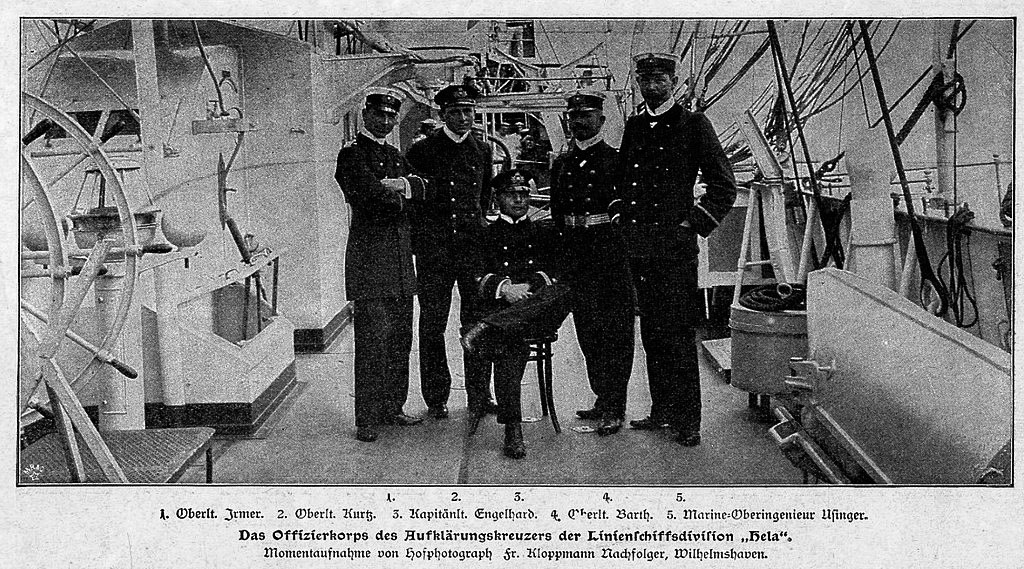
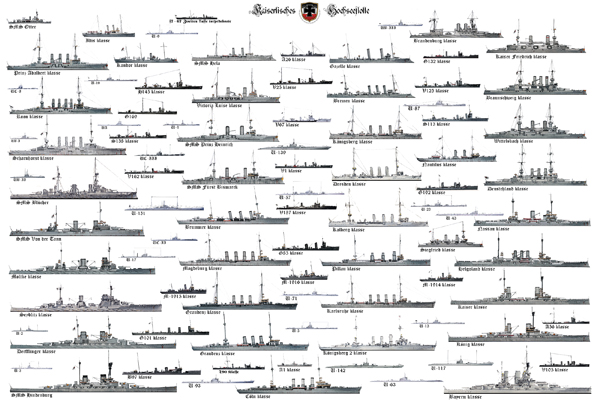
 Latest Facebook Entry -
Latest Facebook Entry -  X(Tweeter) Naval Encyclopedia's deck archive
X(Tweeter) Naval Encyclopedia's deck archive Instagram (@navalencyc)
Instagram (@navalencyc)





 French Navy
French Navy Royal Navy
Royal Navy Russian Navy
Russian Navy Armada Espanola
Armada Espanola Austrian Navy
Austrian Navy K.u.K. Kriegsmarine
K.u.K. Kriegsmarine Dansk Marine
Dansk Marine Nautiko Hellenon
Nautiko Hellenon Koninklije Marine 1870
Koninklije Marine 1870 Marinha do Brasil
Marinha do Brasil Osmanlı Donanması
Osmanlı Donanması Marina Do Peru
Marina Do Peru Marinha do Portugal
Marinha do Portugal Regia Marina 1870
Regia Marina 1870 Nihhon Kaigun 1870
Nihhon Kaigun 1870 Preußische Marine 1870
Preußische Marine 1870 Russkiy Flot 1870
Russkiy Flot 1870 Svenska marinen
Svenska marinen Søværnet
Søværnet Union Navy
Union Navy Confederate Navy
Confederate Navy Armada de Argentina
Armada de Argentina Imperial Chinese Navy
Imperial Chinese Navy Marinha do Portugal
Marinha do Portugal Mexico
Mexico Kaiserliche Marine
Kaiserliche Marine 1898 US Navy
1898 US Navy Sovietskiy Flot
Sovietskiy Flot Royal Canadian Navy
Royal Canadian Navy Royal Australian Navy
Royal Australian Navy RNZN Fleet
RNZN Fleet Chinese Navy 1937
Chinese Navy 1937 Kriegsmarine
Kriegsmarine Chilean Navy
Chilean Navy Danish Navy
Danish Navy Finnish Navy
Finnish Navy Hellenic Navy
Hellenic Navy Polish Navy
Polish Navy Romanian Navy
Romanian Navy Turkish Navy
Turkish Navy Royal Yugoslav Navy
Royal Yugoslav Navy Royal Thai Navy
Royal Thai Navy Minor Navies
Minor Navies Albania
Albania Austria
Austria Belgium
Belgium Columbia
Columbia Costa Rica
Costa Rica Cuba
Cuba Czechoslovakia
Czechoslovakia Dominican Republic
Dominican Republic Haiti
Haiti Hungary
Hungary Honduras
Honduras Estonia
Estonia Iceland
Iceland Eire
Eire Equador
Equador Iran
Iran Iraq
Iraq Latvia
Latvia Liberia
Liberia Lithuania
Lithuania Mandchukuo
Mandchukuo Morocco
Morocco Nicaragua
Nicaragua Persia
Persia San Salvador
San Salvador Sarawak
Sarawak Uruguay
Uruguay Venezuela
Venezuela Zanzibar
Zanzibar Warsaw Pact Navies
Warsaw Pact Navies Bulgaria
Bulgaria Hungary
Hungary

 Bundesmarine
Bundesmarine Dutch Navy
Dutch Navy Hellenic Navy
Hellenic Navy Marina Militare
Marina Militare Yugoslav Navy
Yugoslav Navy Chinese Navy
Chinese Navy Indian Navy
Indian Navy Indonesian Navy
Indonesian Navy JMSDF
JMSDF North Korean Navy
North Korean Navy Pakistani Navy
Pakistani Navy Philippines Navy
Philippines Navy ROKN
ROKN Rep. of Singapore Navy
Rep. of Singapore Navy Taiwanese Navy
Taiwanese Navy IDF Navy
IDF Navy Saudi Navy
Saudi Navy Royal New Zealand Navy
Royal New Zealand Navy Egyptian Navy
Egyptian Navy South African Navy
South African Navy






























 Ukrainian Navy
Ukrainian Navy dbodesign
dbodesign